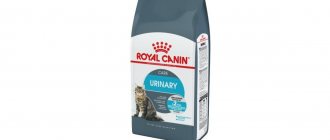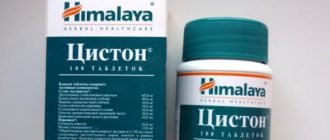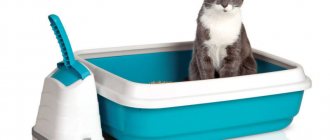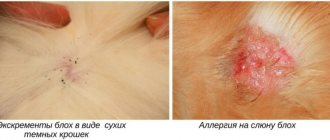The main symptoms of pinworms in cats
The main signs that a cat is infected include:
- weakness;
- apathetic behavior;
- decreased appetite;
- diarrhea or constipation;
- itching near the anus.
In advanced cases, problems with the coat appear - at first it becomes dull, then it begins to actively fall out. There may be discharge from the eyes. If the animal has other diseases, they become aggravated and become severe.
Some cats have problems with the locomotor system, dystrophy of internal organs, and as a result – anemia.
Pinworms pose the greatest danger to small kittens, as they can be fatal.
Symptoms
The clinical picture is not very noticeable, but some signs attract attention:
- In the initial period of the disease, in the first few days, one may notice enlarged lymph nodes, increased body temperature, a dry and hot nose, sneezing or coughing.
- As the disease progresses, disorders of the gastrointestinal system develop. It manifests itself mainly in the form of liquid or liquefied stool, which may contain mucus or blood.
- Sometimes the cat's abdomen becomes noticeable: it becomes swollen, and gas is released. The cat does not allow you to touch its belly; its behavior is restless.
- Then dyspeptic disorders occur, the cat loses its appetite, and in most cases vomiting occurs. Not a single dish makes you want to eat, even your favorite one.
- Unusual behavior appears, which is characterized by eating inedible things. The cat may eat pebbles, paper or anything else, preferring solid objects.
- Symptoms of intoxication become more and more pronounced. The waste products of the parasite have an increasing impact on the cat’s body. The animal is lethargic, apathetic, sickly in appearance, behaves aggressively, gets tired quickly and looks drowsy.
- Allergic reactions are possible, which manifest themselves in itching and redness of the skin. The animal is constantly itching, leaving bloody scratches.
- Pinworms have their own peculiarity. When a sexually mature individual, while in the body, needs to lay its eggs, it descends to the lowest part of the intestine to the anus. Then the pinworm secretes a special secretion so that the laid eggs have the opportunity to attach, leaves the offspring and returns back to its usual place of attachment. This process causes severe itching in the anus. The cat begins to rub this area on the floor and tries to wash itself in this area as often as possible.
However, the presence of the above symptoms does not always make the owner suspect that his pet has a parasite. In most cases, a person understands that his pet has helminthiasis only when he discovers white larvae in the animal’s feces.
Treatment and rules for choosing drugs
You can destroy worms in the body of cats with the help of anthelmintic drugs.
There are two groups of medications:
- with one active ingredient, which is aimed at destroying a specific type of parasite;
- combination medications that can destroy several types of helminths in one or several doses.
Most often, it is recommended to choose combination drugs, since it is rare for a cat to have only pinworms in its body. It is important that the drug is able to combat worms at any stage of their development.
Parasite
This particular drug is a broad-spectrum drug. It is capable of destroying almost all known types of worms. The effectiveness is noticeable after a single dose. Moreover, a positive result is observed in almost 98% of sick animals.
The parasite is well tolerated by adult and healthy cats, kittens and cats that feed babies. Suitable even for use during pregnancy. The remains of the drug are eliminated from the body within a day.
Drontal
It also belongs to the category of combined drugs and allows you to get rid of almost all parasites. It is used not only as a remedy, but also for prevention. Prevention with this drug is carried out 4 times a year, always before breeding or vaccination.
Before taking the drug, you should not “put” the cat on a diet or give laxatives. If you use the product correctly, without violating the recommended dosage, there will be no contraindications or side effects.
Attention! Anthelmintic treatment involves preliminary removal of fleas, which are carriers of parasites.
Pyrantel or Embovin
The product allows you to rid cats not only of pinworms, but also of hookworms and roundworms, and has little effectiveness in the fight against trichuriasis. It refers to drugs that are used to treat people - when choosing a dosage, you need to take this into account.
Polyvercan or sugar cubes
Belongs to the category of widely used products. The drug contains Oxibendazole and Niclosamide. This combination of anthelmintic active ingredients can cure a cat of almost all known worms. It is a safe product.
The drug can be given undiluted or dissolved in water. There are no contraindications to the use of polyvercan. It can be used even during the period of estrus, the main thing is not to violate the specified dosage.
What to do if cats become infected with worms?
Diagnostics
To identify such helminths, it is enough to do an analysis of the animal’s feces.
If there is a suspicion of pinworms, the owner should observe the pet's feces. Parasites can often be seen with the naked eye. If worms are not found in the feces, but the symptoms are severe, it is recommended to contact a veterinary clinic. To identify parasites, stool is examined for worm eggs, with repeated analysis after 2-3 weeks.
Treatment with drugs
Medicines are prescribed by a veterinarian; self-medication can worsen the condition. To expel pinworms from a cat, medications are prescribed, such as:
- "Prasitel";
- "Drontal";
- "Polyverkan";
- "Pyrantel";
- "Embowin."
Folk remedies
Herbal decoctions can be given to a cat only after consultation with a veterinarian. Using wormwood tincture in alcohol is effective. To do this you need 10 drops. dilute a little with water and pour into the animal’s mouth using a syringe without a needle. Pinworms in cats can also be expelled with decoctions of chamomile, fennel, and tansy herbs. Preparation:
To rid your pet of infestation, you can use tansy.
- Take 5 g of the plant and pour 200 ml of boiling water.
- Leave for 1 hour, filter.
- Give to the cat 60 minutes before. before meals 3 r. per day 5 ml.
Can a person become infected from a sick animal?
It is difficult to become infected with pinworms from cats, but worm larvae can be found on the animal’s fur and accidentally enter the human body.
Therefore, you should carefully monitor the health of the animal, especially if there are small children in the house.
They are the ones who are most often exposed to infection, since they have a lot of contact with animals. Owners should not forget about hygiene rules. They must be strictly observed and taught to children. You should always wash your hands after touching an animal, even if it is domestic and well-groomed.
Causes of infection
The main cause of parasite damage to any cat living at home is the problem of improper nutrition . Various products such as meat, fish or poultry may contain helminth eggs in significant quantities. They can die only with sufficient heat treatment, the temperature at which reaches 180 degrees, or with prolonged freezing (about a week). If a pet is constantly fed raw meat, then the risk of eggs entering the gastrointestinal tract and infection increases to its maximum.
The most likely cause of infection is cats that constantly walk outside. The cat constantly comes into contact with street animals that may have pinworms and their feces, as well as with the ground. In soil and vegetation, pinworms can remain active for infection for many months.
Another route of infection is provided by the host himself. If the animal does not walk on the street, but lives only at home, it can get parasite eggs from the owner’s shoes or clothes that he was wearing outside. More often, this type of infection is facilitated by feeding the pet dry food, which contains practically no useful elements and vitamins.
Possible complications after taking anthelmintic drugs
Most often, anti-parasite medications cause general intoxication. After taking the drug, the worms decompose and harm the cat’s body.
Problems can also arise if the recommended dose is exceeded, especially if this happens regularly. Symptoms of side effects include:
- vomit;
- muscle tremors;
- blanching of the mucous membranes;
- breathing problems.
If such symptoms occur, you should immediately contact a veterinary clinic.
Diagnostics
In most cases, diagnosis of the disease consists of visually identifying the parasite in the animal's feces . The conclusion about a specific type of disease depends directly on the appearance of the worm. Pinworms are characterized by elongated white larvae.
If it is not possible to visually detect the parasite in the feces, but the clinical picture characteristic of helminthiasis is present, then take the feces for analysis. Next, in a specialized laboratory, the feces are examined, and a conclusion is made about the presence of the parasite and its species.
In case of a negative result of a stool test while symptoms persist, a repeat examination of the stool is performed.
How to treat cats at home
If you need to give your pet medicine at home, you can use one of the methods.
- The tablet is crushed and diluted in a small amount of water. The resulting composition is drawn into a syringe without a needle, which is carefully placed behind the animal’s cheek and the medicine is poured in. After this, the cat’s mouth is closed so that it does not spit out the composition.
- The tablet does not need to be diluted in water - in this case, the cat is placed in the arms, with its back to the owner’s body, the mouth is opened and the tablet is placed there. After this, the mouth is closed and the animal’s neck is lightly stroked until it swallows the medicine.
- You can mix the crushed medicine with the food. As a rule, this method works quickly.
Cucumber tapeworm
Cucumber tapeworm (lat. Dipylidium caninum), or dog tapeworm, is a helminth from the class of cestodes (tapeworms) that is the causative agent of dipylidiosis. The adult worm mainly parasitizes the body of a dog or cat, but is rarely found in humans. Human infection occurs through accidental ingestion of an infected flea, dog lice, or through the saliva of animals. Young children who come into contact with their pets are especially susceptible to the disease.
Structure
The length of an adult worm is about 10-70 cm. The width of the parasite's body reaches 2-3 mm. The scolex (head) has a proboscis and four suckers. The anterior part of the head section contains hooks arranged in 8 rows, with which the helminth is attached to the walls of the host's intestines. Ripe segments (proglottids) look like cucumber seeds, hence the name of the parasite.
Life cycle
The definitive hosts of parasites are dogs, sometimes cats, and in rare cases people (usually small children). Intermediate hosts are fleas and dog lice eaters. The life cycle begins when active segments are excreted from the host in feces. After the destruction of their shells, the eggs come out.
The final animals are also representatives of the canine family (dogs, wolves, foxes) cats, raccoons. When a person or animal swallows an infected adult flea, infection occurs. The parasite enters the body of the final host and immediately attaches to the wall of the small intestine. There, the helminth develops into an adult worm, which reaches maturity about a month after infection. The life cycle is completed when the segments with eggs are released into the external environment with feces.
Prevalence
Cucumber tapeworm is ubiquitous. The greatest threat of infection is observed in animal kennels and dog walking areas.
In humans, infection with cucumber tapeworm is very rare. But if this does happen, it is more often in young children. Only 16 cases of this parasite in humans have been reported over the past 20 years, and almost all involved children. Such cases have occurred in Europe, the Philippines, China, Japan, Argentina and the United States.
Young children and toddlers are at greater risk of infection due to their particularly close contact with pets. People become infected accidentally by ingesting an infected flea, pet saliva, or eating contaminated food.
Cucumber tapeworm does not usually cause symptoms in dogs or cats, and most pets do not show any symptoms other than increased appetite. One of the possible signs may be the animal's attempts to rub its butt on the ground or floors in the house, which is caused by pain and itching when the mature segments of the worm come out along with the eggs.
For treatment, tablets that are sold in veterinary pharmacies and contain praziquantel are sufficient.
Prevalence
Types of parasites
Roundworms, tapeworms and flat flukes are the three groups of parasites that are most common among the cat family. Therefore, during invasion, different organs are affected depending on the location of the helminths: intestinal tract, liver, heart, lungs and, based on this, the clinical picture appears.
The most common infection diagnosed in cats is roundworms. They enter the body of pets with food, raw meat, meat products and from other animals. Kittens can become infected while still in the cat's womb, since, for example, roundworms are able to cross the placental barrier with blood and penetrate the fetus. Nematodes migrate throughout the body, but most of all they prefer to be localized in the intestines and bile ducts, clogging them. Nematode excrement is very toxic to animals.
Nematodes are small helminths, their body length varies from a few millimeters to 2-3 cm.
We suggest you familiarize yourself with the difference between a baby pinworm and a roundworm
Types of worms found in cats
Tapeworms or cestodes are much longer than nematodes. They grow in the host’s body up to 70 cm. Each individual consists of numerous segments - segments filled with eggs. Infection occurs by eating raw or undercooked meat, as well as through intermediate carriers - fleas and lice-eaters. It is much easier to identify cestodes in cats, since they excrete segments of worms along with feces, which owners so often confuse with pinworms.
Among cestodes in cats, the following types prevail:
- wide tape;
- cucumber tapeworm;
- alveococcus
All of the above helminths are parasitic in the intestines of the animal.
Flat flukes or flukes look like white threads. Their body is equipped with suction cups with which they attach to the intestinal epithelium, causing microtrauma and poisoning it with toxins. Flukes are less common than cestodes and nematodes in infecting cats, but they are much more dangerous, and the infestation is often fatal.
Domestic four-legged animals are carriers of worms
Cats are owners of pinworms and their carriers. Infecting humans with worms from cats can be avoided. Experts say that numerous helminths present in animals become quite dangerous to human health if they are passed on from four-legged friends. In some cases, they damage the intestinal mucosa, liver, kidneys, thyroid gland, respiratory organs, and sometimes the brain, cardiovascular system, and visual organs.
Animals in the house significantly increase the chance of people contracting worms from them, especially for children. Parasites are transmitted from animals to humans quickly through contact with them and in case of ignoring the rules of personal hygiene.
Four-legged furry household members are clean animals, but this fact does not guarantee the absence of pinworms and other helminths. By licking their fur, cats help distribute parasite eggs throughout the hair. In this case, the animal spreads worms with its tongue over the entire surface of its body. And if after this you or your child stroked your tailed friend’s fur, the fact of infection cannot be ruled out. In order to avoid becoming infected with helminthic disease, you must thoroughly wash your hands with soap after each touch of your pet's fur.
A huge accumulation of worm eggs is located in the cat's litter box, which come with feces. Even with daily thorough cleaning of the animal's toilet, there is no guarantee of getting rid of intestinal parasites.











